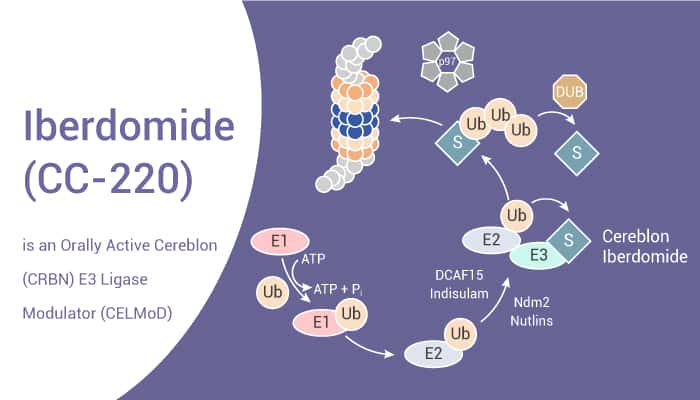Cereblon (CRBN) is a key protein in autosomal recessive nonsyndromic mental retardation. Specifically, it plays an intermediary role in helping immunomodulatory drugs play their immunomodulatory and tumor-killing roles. Besides, CRBN is highly conserved from plants to mammals, and mRNA expression in humans, rats, and mice is common. CRBN interacts with regulators of DNA damage binding protein-1 (DDB1), Cullin 4 (Cul4A or Cul4B), and Cullins 1 (RoC1). Moreover, this can form a functional E3 ubiquitin ligase complex. In this complex, CRBN acts as a substrate receptor for the E3 ubiquitin ligase complex. And it targets proteins for protein hydrolysis through ubiquitin proteasome pathway. Furthermore, CRBN promotes large conductive calcium-activated potassium (ubiquitinated calcium of BK) channels, chloride channel protein 1 (CLC-1) and presynaptic proteins
Meanwhile, CRBN is the substrate receptor of the Cullin 4-ring E3 ligase complex, which has been used for targeted protein degradation in cancer therapy. CRBN plays a protective role against DNA damage-induced apoptosis in cell lines and primary cells. Nonetheless, CRBN also enhanced the ubiquitination and degradation of c-Jun. Importantly, CRBN reduces the activity of c-jun related transcription factors, thereby inhibiting the lipopolysaccharide-induced inflammatory response. Today, we will introduce an orally active and potent cereblon (CRBN) E3 ligase modulator (CELMoD), Iberdomide (CC-220).
Iberdomide (CC-220) is an Orally Active Cereblon (CRBN) E3 Ligase Modulator (CELMoD).

Above all, Iberdomide is a CELMoD with an IC50 of ~150 nM for cereblon-binding affinity. Particularly, Iberdomide, a derivative of Thalidomide, has antitumor and immunostimulatory activities.
Next in importance, Iberdomide with 0.01-10 μM for 72-96 hrs has antiproliferative effects in a panel of multiple myeloma (MM) cell lines. These MM cell lines are EJM, H929, KMS11, KMS128M, KMS12PE, MM1.S, MM1.R, RPM-8226, U266 cells. Obviously, Iberdomide induces apoptosis in all MM cell lines. Iberdomide results in time-dependent increases in G0/G1 and sub-G1 cell cycle fractions on H929 cells. Interestingly, Iberdomide leads to rapid Aiolos depletion in the KMS12BM line. Iberdomide displays some anti-proliferative activity in two of the Pomalidomide-resistant (PR) lines with cereblon mutations along with decreased levels of cereblon protein. Additionally, Iberdomide equally induces PBMC-mediated killing of both parental MM1.S cells and MM1.S/PR cells.
Once again, Iberdomide with 10 mg/kg by oral gavage after 6 or 24 hours causes higher hCRBN expression in hC343 splenocytes. By the way, it correlated to deeper IKZF1/3 downregulation in WT (C57BL/6), hC123, or-343, and mCrbn-/- mice.
References:
Chad C Bjorklund, et al. Leukemia. 2020 Apr;34(4):1197-1201.